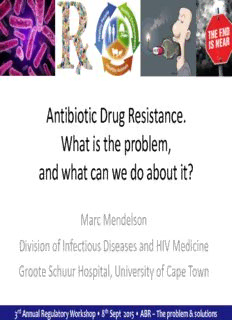
Mendelson - Antibiotic drug resistance-What is the problem, and what we can do about it PDF
Preview Mendelson - Antibiotic drug resistance-What is the problem, and what we can do about it
Antibiotic Drug Resistance. What is the problem, and what can we do about it? Marc Mendelson Division of Infectious Diseases and HIV Medicine Groote Schuur Hospital, University of Cape Town 3rd Annual Regulatory Workshop • 8th Sept 2015 • ABR – The problem & solutions Disclosure of Interests • MSD - Travel Grants to attend European Congress on Clinical Microbiology and Infectious Diseases (ECCMID) – 2013, 2014, 2015 • Sanofi, GSK, Aspen, MSD – speaker honoraria (non- promotional lectures) • Pfizer – Advisory board for Pneumococcal vaccines Antibiotics are life-saving medicines Survival – Patients with Septic Shock 82% 77% n = 2,731 70% 61% 57% 50% 43% 32% 26% 19% 9% 5% Time to Appropriate Antimicrobial Rx following Onset of Hypotension (Hrs) Kumar et al. Crit Care Med. 2006 Jun;34(6):1589-96. The Problem Antibiotic use drives the emergence of antibiotic resistance LepperPM et al. AntimicrobAgents Chemother2002;46:2920-5. First reported cases of bacterial resistance to key antibiotics [First organism reported to be resistant] Bars represent the amount of time taken for bacteria to develop resistance after market introduction Green year = Market introduction Red year = 1stresistance case reported Slide courtesy of Ramanan Laximanarayan Metagenomic analysis of 30,000 year old permafrost samples – b-Lactam resistance - bla TEM – Tetracycline resistance - TetM – Vancomycin resistance - VanX – Aminoglycoside-antibiotic- modifying acetyltransferase AAC(3) ribosome methyltransferase – Macrolide, lincosamide and type B streptogramin antibiotic resistance – Erm Horizontal Gene Transfer Slide courtesy of Dr Adrian Brink Antibiotic use selects out resistant bacteria Antibiotic replication Sensitive bacterium Resistant bacterium
Description: